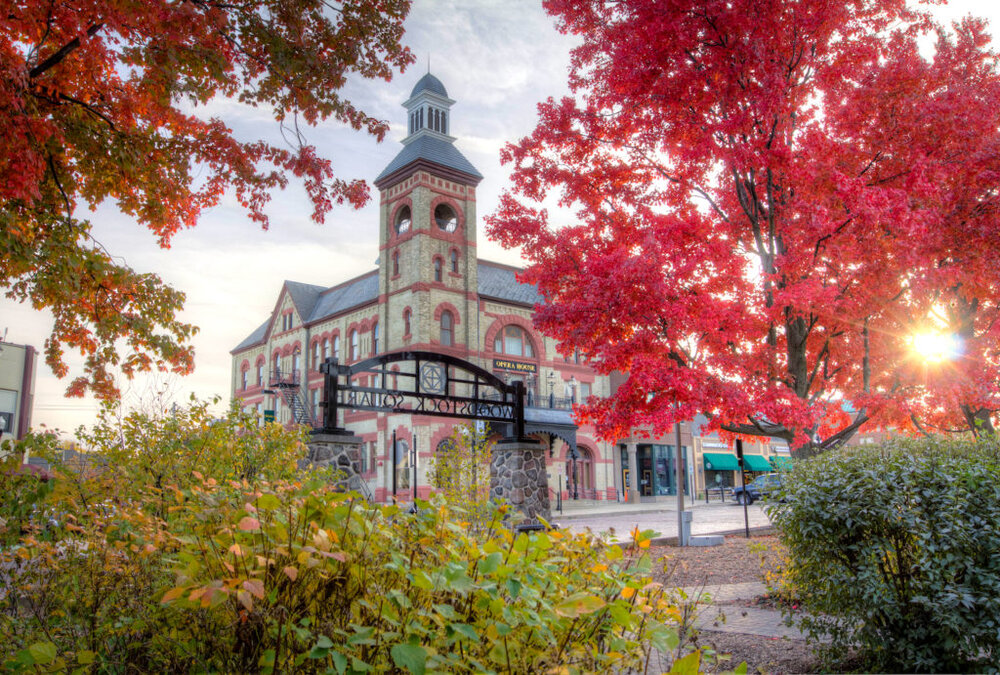Woodstock Opera House: The Jewel of McHenry County
The Woodstock Opera House has survived a fire, vacancy and the threat of demolition to rise as a modern center for the arts.
By Jeff Ruetsche
While many theaters, galleries and concert halls are boasting milestone anniversaries this year, the Woodstock Opera House — nestled in the heart of McHenry County on the picturesque square of Woodstock — briefly noted its 121st year of continuous operation.
Like any elder stateswoman, the passing of the years can go quietly by, practically unnoticed when you reach such a venerable age. Yet, with one look at her majestic Victorian exterior you know immediately that this grand dame of a theater is just hitting her stride. Once inside, guests clearly see why she has endured for so long.
BUILDING A CITY CENTER
The year was 1888 and Alderman W.W. Cook made the motion to purchase a lot on the downtown square in Woodstock, which had remained vacant since a fire in 1871. Having grown tired of holding council meetings in a local attic, the proposal was to build a city hall worthy of the town and its citizens.
However, when put to a vote, the motion came to a tie and it rested on Mayor Merritt Joslyn to cast the deciding vote. Of course he voted in the affirmative and what quickly followed in the next two years was a decision to construct a city building that would house several municipal offices, including the city offices, police and fire departments, a public library and a central gathering place for the community — the Woodstock Opera House.
Smith Hoag, an architect from Elgin, was hired to draw up plans and day laborers were initially hired to begin work on the building. However, after months with very little progress — due to labor issues and material delays — the council contracted Hoag to complete the construction for a fee of $26,000. Simon Brink, whose family had long been connected to the city, was hired to oversee construction, and on September 4, 1890, the grand opening was held with the Patti Rosa Players’ perfor-mance of “Margery Daw.”
Throughout the next few decades, the building functioned as the center of activity for Woodstock and McHenry County. The city offices, library, police and fire department occupied the first floor of the building and the opera house was contained in the second and third floors. With a capacity of almost 700 movable seats, the opera house functioned as a public space for a variety of activities including theatrical events, concerts, weddings, dances, wrestling matches, the annual Strawberry Festival and graduation commencements.
A FIERY THREAT
All these things almost came to an end in 1914 when a fire broke out in the coal bin, located in the basement of the building. Reports tell that two vagrants were living in the basement jail cell and it is believed they inadvertently set the fire while 600 gentlemen were attending a wrestling match in the theater two stories above.
The fire quickly spread up the building following the main stairwell like a chimney. Luckily, the theater was evacuated in time and the only death reported was that of one of the vagrants who started the blaze. The local library lost more than 1,900 books in the blaze.
Evidence of the fire can still be found in charred wood remnants under floorboards.
A LEGENDARY STUDENT
In 1926, a theater-loving young man from Chicago came to Woodstock to enroll in the local Todd School for Boys — his name was Orson Welles. Between the ages of 11 and 16, Welles learned much of his craft on the opera house stage before departing abroad to Ireland. He would return a few years later in 1934 and present a summer of dramas including “Hamlet” and the popular novel-turned-play “Trilby,” which was thought to be the inspiration for Gaston Leroux’s novel “The Phantom of the Opera.”
Welles directed and starred in these productions opposite noted actors Michael MacLiammoir and Louise Prussing, whom he had brought back from his travels in Europe. Roger Hill — the headmaster at the Todd School — even convinced The New York Times to review one of the Shakespearean plays presented that summer.
RESTORATION BEGINS
In 1939, the opera house saw its first expansion when — due in part to years of patron complaints about the odor of horses — the fire department was moved to an addition built at the back of the building.
The local library was also expanded to meet its growing collection. However, during this same period in the 1930s, the building lost the top of its bell tower cupola and the front portico due to extreme deterioration of the materials. It would be 30 years before the cupola was restored and 60 years before the replacement of the portico completed restoration decades in the making.
MULTIPLE PURPOSES, NOTABLE PLAYERS
The opera house served as a location for the services of the Red Cross during World War II after which a small group of veterans launched the McHenry County Theatre Guild. The guild assisted in the creation of The Woodstock Players in 1947, which drew members from graduates of the Goodman Theatre in Chicago.
Through the early ’50s, notable actors such as Paul Newman, Tom Bosley, Geraldine Page, Lois Nettleton, Betsy Palmer and Shelley Berman honed their skills on the Woodstock Opera House stage each evening while holding day jobs at local shops in town.
A PHOENIX RISES
Sadly, the opera house declined in use over the next decade with the library relocating in 1959 and the fire department in 1965.
As parts of the building were vacated, much of the facility fell into disrepair. But hope came in 1960 when the Junior Civic Arts League was founded as a group of young people dedicated to presenting plays and endeavoring to repair the opera house to its former glory. The league gave rise to other supporting organizations over the next decade such as the Woodstock Fine Arts Association, founded in 1961, whose efforts set the stage for the restoration project to come.
Woodstock gained national recognition in 1964 when it was named an “All-America City” by the National Municipal League. This honor was given due to the exemplary participation of Woodstock citizens toward the improvement of the community. This award fueled the idea of community partnerships and in 1965 and 1966 the city invested nearly $40,000 in repairs to the interior and exterior of the opera house.
Over the next decade, a tremendous push toward the full restoration of the building was enacted. In 1972 — after much political wrangling, in which it was suggested the structure be torn down and made into a parking garage — the city officially declared, by ordinance, that the Woodstock Opera House be named a historic landmark. This was quickly followed in 1974 by the placement of the building on the National Register of Historic Places.
By this time, the city had moved all of its offices to other locations, leaving just the opera house building. With the formation of the Woodstock Opera House Community Center Inc. as a fundraising body, the building was completely restored in 1976 for $500,000 with architect John Vincent Anderson overseeing the effort.
Reopening as the official Woodstock Opera House Community Center in February 1977, the building was once again a thriving arts center, fully mod-ernized, yet historically intact.
Over the next 30 years, the Woodstock Opera House transitioned to the modern facility it is today. Staff was hired to operate the theater, and minor restoration projects continued to enhance the beauty and historical accuracy of the building. In 1999, the imposing front portico of the building was reconstructed, and after almost 20 years, restoration was complete.
A CROWN JEWEL THRIVES, GROWS
A product of its own success, it was soon determined that the Woodstock Opera House needed to expand. The lot next door, long vacant, was purchased by the city, and in 2003 the opera house annex was completed. Almost one-third the size of the opera house, the annex provided much-needed space for offices, backstage areas, a massive freight elevator, restrooms and the most popular aspect, Stage Left Café. Decorated in a backstage motif, Stage Left offers regularly scheduled entertainment and can be rented out for private functions.
Annually, the Woodstock Opera House hosts more than 600 amateur and professional events, and activities. Much like it was in its early years, it serves the community as a gathering place for programs of every size and scope. Today, it’s the resident home to two community theater companies — TownSquare Players and Woodstock Musical Theatre Company. It’s also home to the Judith Svalander Dance Theatre, the Woodstock Mozart Festival and after almost 50 years in service, the Woodstock Fine Arts Association.
Whether you call it the “Opera House,” “Old City Hall,” the “Crown Jewel of McHenry County” or, in the words of Orson Welles, “the grand capital of mid-Victorianism in the Midwest,” the Woodstock Opera House continues to endure and flourish as the center of the arts in northern Illinois.

